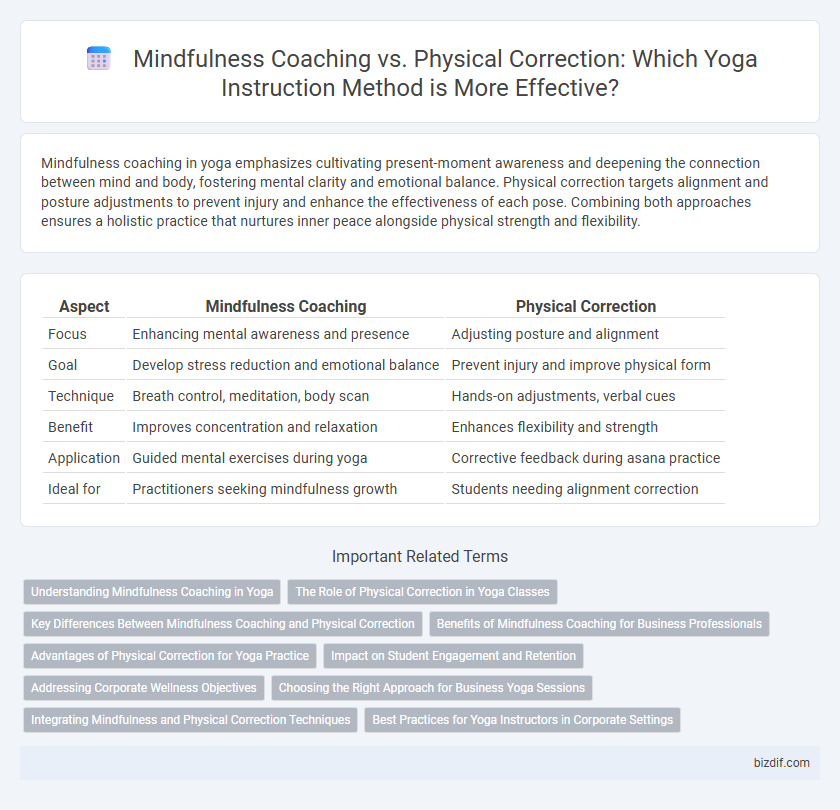Mindfulness coaching in yoga emphasizes cultivating present-moment awareness and deepening the connection between mind and body, fostering mental clarity and emotional balance. Physical correction targets alignment and posture adjustments to prevent injury and enhance the effectiveness of each pose. Combining both approaches ensures a holistic practice that nurtures inner peace alongside physical strength and flexibility.
Table of Comparison
| Aspect | Mindfulness Coaching | Physical Correction |
|---|---|---|
| Focus | Enhancing mental awareness and presence | Adjusting posture and alignment |
| Goal | Develop stress reduction and emotional balance | Prevent injury and improve physical form |
| Technique | Breath control, meditation, body scan | Hands-on adjustments, verbal cues |
| Benefit | Improves concentration and relaxation | Enhances flexibility and strength |
| Application | Guided mental exercises during yoga | Corrective feedback during asana practice |
| Ideal for | Practitioners seeking mindfulness growth | Students needing alignment correction |
Understanding Mindfulness Coaching in Yoga
Mindfulness coaching in yoga emphasizes cultivating present-moment awareness and deepening the connection between breath, body, and mind to enhance self-regulation and emotional resilience. Unlike physical correction, which focuses on alignment and posture adjustments, mindfulness coaching nurtures inner awareness and mental clarity as central components of practice. This approach helps practitioners develop a sustainable yoga experience that integrates well-being beyond the physical poses.
The Role of Physical Correction in Yoga Classes
Physical correction in yoga classes plays a critical role in aligning postures safely, reducing injury risk, and enhancing practitioner awareness of body mechanics. Skilled instructors use tactile adjustments and verbal cues to guide students into optimal form, which deepens the physical benefits of asanas and supports long-term progress. This hands-on approach complements mindfulness coaching by anchoring mental focus through precise bodily experiences.
Key Differences Between Mindfulness Coaching and Physical Correction
Mindfulness coaching in yoga emphasizes cultivating present-moment awareness and mental clarity, enhancing the practitioner's internal experience and emotional regulation. Physical correction concentrates on adjusting body alignment and posture to improve anatomy, prevent injury, and maximize physical benefits of each pose. The key differences lie in mindfulness coaching targeting mental and emotional states, while physical correction prioritizes biomechanical precision and physical health.
Benefits of Mindfulness Coaching for Business Professionals
Mindfulness coaching enhances focus, reduces stress, and improves emotional resilience, making it essential for business professionals navigating high-pressure environments. Unlike physical correction, mindfulness training fosters mental clarity and decision-making skills that boost productivity and workplace well-being. Integrating mindfulness practices into daily routines supports sustained performance and effective leadership.
Advantages of Physical Correction for Yoga Practice
Physical correction in yoga practice enhances alignment precision, reducing the risk of injury and promoting effective muscle engagement. It allows instructors to provide immediate, personalized adjustments that deepen posture understanding and improve body awareness. This hands-on approach accelerates skill development and fosters a safer, more efficient practice compared to mindfulness coaching alone.
Impact on Student Engagement and Retention
Mindfulness coaching in yoga enhances student engagement by fostering self-awareness and emotional regulation, which deepens their connection to practice and promotes long-term commitment. Physical correction, while important for alignment and injury prevention, may not sustain motivation if used as the primary teaching method. Integrating mindfulness techniques leads to higher retention rates by creating a more supportive and personalized learning environment.
Addressing Corporate Wellness Objectives
Mindfulness coaching in yoga prioritizes mental clarity, stress reduction, and emotional resilience, directly aligning with corporate wellness goals of enhancing employee well-being and productivity. Physical correction emphasizes improving posture, flexibility, and injury prevention, supporting corporate objectives related to physical health and reducing workplace injuries. Integrating both approaches creates a holistic wellness program that meets diverse corporate needs for a healthier, more engaged workforce.
Choosing the Right Approach for Business Yoga Sessions
Mindfulness coaching enhances yoga sessions by fostering mental clarity, emotional balance, and stress reduction, crucial for corporate wellness programs. Physical correction emphasizes alignment, injury prevention, and improved posture, ensuring participants gain maximum physical benefit and safety. Selecting the right approach depends on your clients' goals--prioritize mindfulness coaching for mental wellbeing and physical correction for enhancing bodily awareness and technique.
Integrating Mindfulness and Physical Correction Techniques
Integrating mindfulness and physical correction techniques in yoga instruction enhances body awareness and alignment, promoting holistic well-being. Mindfulness coaching cultivates present-moment focus and breath control, which supports precise physical adjustments. This combined approach improves posture, reduces injury risk, and deepens the mind-body connection for a transformative yoga practice.
Best Practices for Yoga Instructors in Corporate Settings
Effective yoga instruction in corporate settings balances mindfulness coaching with physical correction to enhance employee well-being and productivity. Prioritize techniques that cultivate mental clarity and stress reduction through guided breathing and meditation, while carefully applying adjustments that respect individual physical limits and promote proper alignment. Incorporating personalized mindfulness strategies alongside ergonomic posture correction fosters a holistic approach that supports both mental resilience and physical health in the workplace.
Mindfulness Coaching vs Physical Correction Infographic

 bizdif.com
bizdif.com